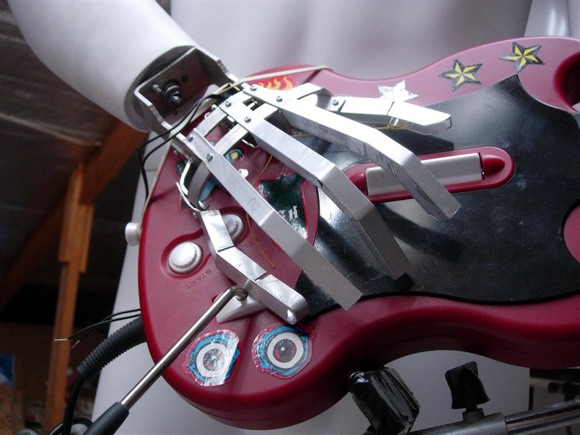
It’s appeared elsewhere, but if you haven’t looked closely at the Guitar Hero-playing robot (“Guitar Heronoid”) created by Rafael Mizrahi and Tal Chalozin of GarageGeeks, you might have missed just how obsessive this project is:
- It has working, robotic hands. The actions are fairly simple: strum and hit buttons. Of course, that’s just the mechanical action…
- It can see. To detect what’s going on in the game, the creators had to create custom image-processing code that would follow the “plates”, the on-screen indicators of notes to play. (It says something about the design of the Guitar Hero interface, in fact, that even a robot can process it.)
- It has delay compensation. The PS2 has an amazing 100ms latency (a tenth of a second, or roughly ten times the amount of latency in most computer music systems). The robot compensates for this delay and other delays in the recognition and performance of notes. (Hey, maybe that’s why I’m so bad at Guitar Hero … yeah, that’s the ticket.)
- It has a brain. You need a brain to perform the above tasks. For now, Guitar Heronoid’s brain is of the simple, electronic kind. But beware: it could be overthrowing its human overlords any day soon.
Skip to the end for the actual playing:
Robots playing games for you … hmmm, this could solve the problem of unfinished games. But there’s also a tendency toward robots that will augment the human musical performer as well as perform on its own.
Ask Harmonix! While I am several months late in noticing this, there is one good reason to bring it up now: roughly concurrent with the launch of the new Rock Band (think Guitar Hero, but a band), I have the good fortune to get to visit Harmonix’s headquarters. Any questions you want me to ask?
Thanks to Pedro Marques for the reminder!
More Robots:
MIDI-Powered Robotic Ballet Mechanique Raises Ruckus at National Gallery of Art
Robot Drummer Responds to Human Playing; How They Did It